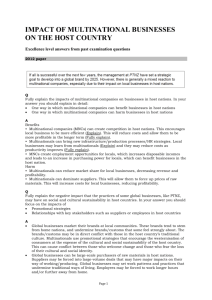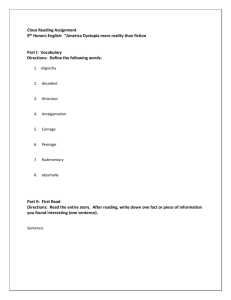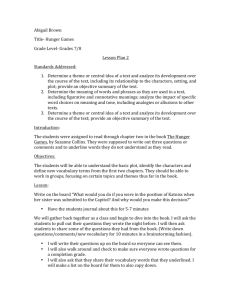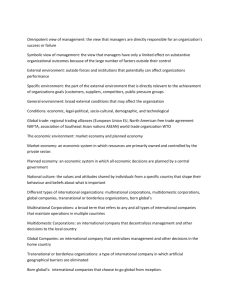Unit 9 The Future
advertisement
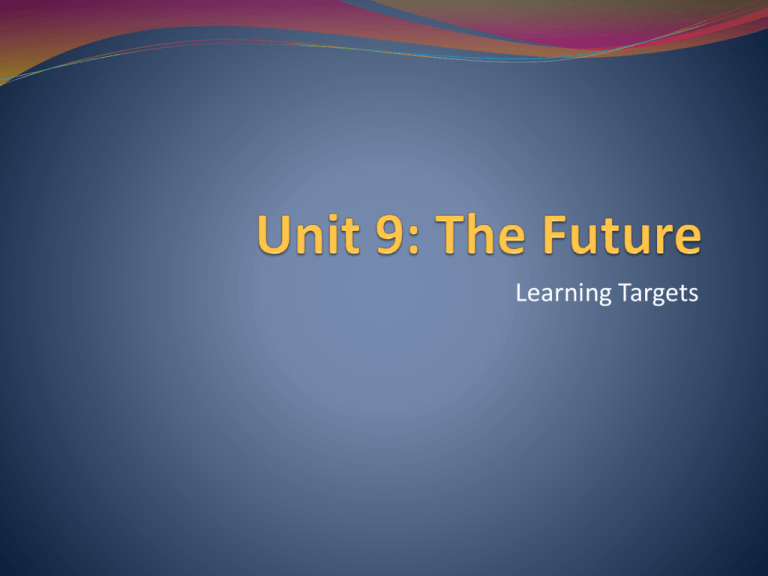
Learning Targets 1. I can explain the reasons for the difficulty in predicting the future. “culture remains the mechanism by which people solve their problems of existence” but, problems of existence seem to be outstripping culture’s ability to find solutions! hard to predict the future rarely look more than 50 years into the future use trends of recent history tendency to treat subjects in isolation agricultural planning in American Southwest tendency to project hopes/expectations of own culture overlooks scientific objectivity hence, holistic, evolutionary perspective, cross-cultural research, recognize/minimize culture-bound theories 2 3 4 5 2. I can define holistic perspective. Holistic Perspective an anthropological methodology meaning … ? anthropologists take into account many interacting factors to understand the functioning of a complex whole for example … ? 6 7 8 9 3. I can define “One World Culture”. One World Culture (quote-page 731) “based largely on the observation that developments in communication, transportation, and trade so link the peoples of the world that they are increasingly wearing the same kinds of clothes, eating the same kinds of foods, reading the same kind of newspapers, watching the same kinds of television programs, and so on.” trend for political units to become larger in size and fewer in number over last 5,000 years logical outcome: reduction to a single one! 10 3. I can define “One World Culture”. One World Culture (quote-page 731) problem with prediction: a resurgence of separatist movements!! all large states have a tendency to come apart! all past empires break-up of the U.S.S.R. Yugoslavia/Czechoslovakia Quebec from Canada Basque/Catalonia from Spain Scottish/Irish/Welsh from Britain Tibet from China Others? 5,000 national groups and 204 recognized countries! 11 12 4. I can define Cultural Pluralism. Cultural Pluralism refers to a situation in which groups with different ways of acting and thinking can interact socially and politically with mutual respect in a society implies the rejection of bigotry and racism implies respect for the cultural traditions of other peoples may constitute a temporary stage in process of integration into a single melting-pot culture may result from conquest may result from several culturally distinct groups that become unified as a larger political entity CLC! Why? 13 4. I can define Cultural Pluralism. Melting Pot Salad Bowl 14 15 5. I can explain the impact of “multinational corporations” in a globalized world. “multinationals” “actually clusters of corporations of diverse nationality, joined together by ties of common ownership and responsive to a common management strategy.” (p. 733) a major force in the world since the 1950’s influence governments government policies benefit companies rather than the people of nation’s Brazil – 1964 development of the Amazon River Basin 16 5. I can explain the impact of “multinational corporations” in a globalized world. “multinationals” problematic on both domestic/international scene Jules Henry (quote- p. 735) working for any large corporation, tends to generate … “… hostility, instability, and fear of being obsolete and unprotected. For most people their job was what they had to do rather than what they wanted to do, … taking a job, therefore, meant giving up part of their selves.” 17 5. I can explain the impact of “multinational corporations” in a globalized world. “multinationals” engender “apathy” among consumers due to inability to respond effectively to complaints Laura Nader (quote- p. 735) “Face-to-faceless relations between producers and consumers, among whom there is a grossly unequal distribution of power, exact a high cost: a terrible sense of apathy, even a loss of faith in the system itself.” “sprawling, anonymous, networks” dependent on sophisticated data-processing systems decisions made by computers Alvin Wolfe’s observation (p. 735, bottom right) 18 5. I can explain the impact of “multinational corporations” in a globalized world. “multinationals” primarily interested in cheap labor favor developing nation’s favor unmarried women high turnover, low wages division of labor where gender discrimination is prominent 19 20 21 22 23 6. I can define ethnocentrism. ethnocentrism the belief that one’s own culture is superior to all others allows a society to function effectively provides a sense of pride and loyalty provides a sense of personal worth Problem: used as a basis for manipulating others cultures for the benefit of one’s own James Monroe – (page 746-47), on Native American rights: “The hunter state can exist …more than is necessary for their support and comfort.” attitude still exists today to justify “development” at the expense of “subsistence farmers, pastoral nomads, or food foragers” 24 25 26 7. I can explain global apartheid. Global Apartheid refers to the incongruence in the use of and distribution of the world’s resources by its collective population compared to the racially segregated policies of South Africa designed to maintain racial segregation and dominance of a “white” minority over a non-white majority in political, social, and economic affairs In the world: the poorest 75% of the population make do with 30% of the world’s energy, 25% of its metals, 15% of its wood, and 40% of its food. the greater percentage of these and other resources goes to the richest 25% of the population.” 27 28 29 30 8. I can explain structural violence. Structural Violence violence exerted by situations, institutions, and social, political, and economic structures effect is violence … … although not the act of a specific individual nuclear power reactor accident Chernobyl, Ukraine, 1986 Bhopal disaster Bhopal, India, 1984 general examples: World Hunger Pollution Population Control 31 8. I can explain the violent structure of world hunger. World Hunger violence due to failure to feed all the world’s people 52 nations producing less food in 1980 than 1970! 42 nations fail to provide caloric requirements of their populations! despite “green revolution”, … … millions on Earth face malnutrition/starvation in U.S. … … 85 million dollars of food thrown away every day! (1994 dollars!) 32 33 34 35 36 37 38 8. I can explain the violent structure of world hunger. World Hunger less with food production than food distribution subsistence farming replaced by … … cash crops for export! to the developed world coffee, tea, chocolate, banana’s, beef, etc… indigenous people relocated urban areas, unproductive land adopt agricultural practices of the “west”? expensive seeds, chemical, petroleum, etc… inefficient! – quote - p. 750 right column “Farming U.S. style is inefficient. For every … causing major public health problems.” 39 40 41 42 43 8. I can explain the violent structure of world hunger. World Hunger population growth rates more than simply adding people increases rate of population growth as more people beget more people! 1850 = 1 billion people 1950 = 2.5 billion people 2013 = 7.129 2050 = projected between 8.3 and 10.9 billion Can we produce enough food for all of those people? Yes! but not if rates continue to grow! 44 45 46 47 8. I can explain the violent structure of pollution Pollution a bigger problem in poor countries use of chemicals banned in developed countries agricultural chemicals poison soils and waters food additives often prove harmful toxic waste produced thru industrial activities factory emissions poison the air “acid rain” contributes to dementia, Alzheimer’s, Parkinson’s pg. 751 – left column – end of 1st paragraph 48 8. I can explain the violent structure of pollution Pollution “development” itself a health hazard indigenous peoples free of “diseases of development” pg. 751 – right column Why “foul our own nest?” philosophical/theological tradition biblical assertion that we have dominion over the earth exploitive world view pg. 751 – bottom right laws passed to remedy situation … … drive multinationals to poorer countries … … with lax laws! 49 50 51 52 53 54 55 56 57 8. I can explain the violent structure of population control. Population Control pg. 753 – left column – end of 1st paragraph “While solving the problem of population growth will not by itself make the other problems go away, it is unlikely that those other problems can be solved unless population growth can be arrested.” Why do poor people have many children? they are the main resource of the poor! labor security for the elderly children actually cost the wealthy money! 58 8. I can explain the violent structure of population control. Population Control “replacement reproduction” when birth and death rates are in equilibrium; people produce no more offspring than necessary to replace themselves when they die. if achieved, populations continue to grow for next 50 years! Cultural/structural obstacles to population control China agricultural advancement slowed patriarchal/patrilocal traditions favor male dominated society female infanticide on rise 59 60 61 8. I can explain the culture of discontent. Culture of Discontent Pg. 755 people’s aspirations far exceed their opportunities unequal access to jobs, housing, sanitation, health care, police/fire protection, etc… right column – last paragraph “What are required … traditional societies of the world.” 62


